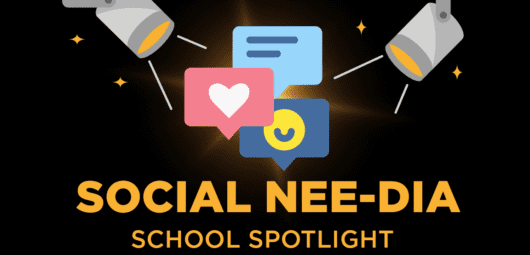Summative Conference Sets Next Professional Learning Focus
The definitive step in the teacher summative evaluation process is the summative conference that occurs between the school leader and the teacher. The actual feedback, planning, and support that occur during the summative conference set the tone for a teacher’s continued professional growth journey. Don’t overlook the importance of this conversation.
As school leaders prepare for the summative conference, the Network for Educator Effectiveness offers the following suggestions.
Follow the Guide to Effective Feedback Conversations
The summative conference should be a conversation, not an interview or an interrogation. Follow the 3 Golden Rules and 5 Step Process to Giving Effective Feedback, outlined in NEE’s Guide to Effective Feedback Conversations:
Prepare for the Conference
Prepare for the conference by generating the teacher’s summative report in the NEE Data Tool and reviewing the data. Make sure all classroom observations, student survey results, and other scorings appear as you expect in the summative report. You may also review the comments you have entered during classroom observations; you can see those comments by clicking View Classroom Observation Reports on the My Teachers menu. After reviewing the data, you may choose to enter general comments on the summative report and then click the Complete Later button to save your work. (You may click Complete For Teacher Review, if you would like the teacher to see the report before the conference, but you want to make sure the summative conference is scheduled within 14 days before you do this.) You can also download the summative report as a PDF to share with the teacher during the conference.
When you look at the report as a whole, what key trends emerge? What are the teacher’s strengths? Where did improvements occur? What could be the teacher’s next professional learning focus?
Give the teacher time to prepare also. Schedule the conference with at least a week’s notice, and let the teacher know of any items you would like them to prepare to discuss. For instance, you might ask them to reflect on strengths that have emerged in their teaching and professional development opportunities they would like to pursue.
Also think about where to hold the conference. Will you meet in the teacher’s classroom, in your office, or in a neutral location? Each place sends a different message and might affect how open the teacher is to the conversation.
Present the Data
Meet face-to-face with the teacher, if possible, or video conference. To begin the conversation, introduce and review the data in the summative report and classroom observation comments. Discuss the evidence collected over the summative cycle with the teacher. Don’t offer your opinion; review the data objectively. You can conduct this step relatively quickly to avoid dwelling on the scores, and begin to move into a forward-looking conversation.
Discuss the Focus
You’ll want to spend the most time on this step: discussing the focus. The summative conference is the perfect opportunity to set the focus for next year’s professional development plan.
Avoid telling the teacher what you think needs to happen in relation to their PD, and let the teacher take the reins. Although you may have your own ideas, it’s important for the teacher to have the opportunity to develop their own ideas.
Pose questions and pay attention to what is said and how it is said. Ask for clarification or for the teacher to expand on their thinking. After the teacher has responded, paraphrasing what they said can be an effective tool to ensure you have the same understanding.
Some questions you might consider asking include:
- Which teaching strategies did you improve upon the most this year?
- What are some opportunities for professional development that you would like to pursue?
- How can I best support your professional learning?
After asking these questions and engaging in conversation, the teacher’s professional development focus should become clear. As the school leader, you should ensure the professional focus also aligns with school or district goals.
Make a Plan
Next, it’s time to work together to develop the plan. What will be the teacher’s primary goal for the upcoming year, and what steps will be necessary to achieve it? What resources could be used?
It’s worth repeating: The summative conference is a great opportunity to jump-start the professional development plan for the next school year. If time allows, you might open NEE’s Teacher Professional Development Plan organizer and begin working on the initial pre-implementation sections. (Important: If you do this step in the spring, you will download the Word version of the TPDP organizer on the Help and Resources menu and save it on your local drive. The online version of the TPDP organizer cannot be accessed until the school year rollover in early July, so work inside the Word version of the document for now, make sure to save it, and then the teacher can copy and paste into the online organizer later.)
If you don’t start the PD plan during the conference itself, make sure the teacher knows the timeline for completing the pre-implementation section of the PD plan. It’s a good idea to get this section done before the end of the school year, so the teacher can immediately begin the professional learning steps in the fall.
Follow Up
As the summative conference ends, now is a good time to click Complete For Teacher Review, if you haven’t already done so, on the summative report within the Data Tool. Clicking the gold Complete For Teacher Review button will officially close the summative cycle and make the report available for the teacher to review. (If you never click Complete For Teacher Review, the summative cycle will stay open and data will carry over to the following school year.)
Important: Remind the teacher to log in to the Data Tool within 14 days to verify they have seen the summative report and met with you. If they do not do this step, the Data Tool will indicate the summative conference did not occur.
The summative conference represents the end of one summative cycle, so celebrate the successes that have been realized and the improvements that were made. Then, commit to be a partner in the teacher’s professional growth journey. Make a plan to provide timely, ongoing, and consistent feedback over the course of the school year to support the teacher and help them achieve their professional learning goals.
The Network for Educator Effectiveness (NEE) is a simple yet powerful comprehensive system for educator evaluation that helps educators grow, students learn, and schools improve. Developed by preK-12 practitioners and experts at the University of Missouri, NEE brings together classroom observation, student feedback, teacher curriculum planning, and professional development as measures of effectiveness in a secure online portal designed to promote educator growth and development.



